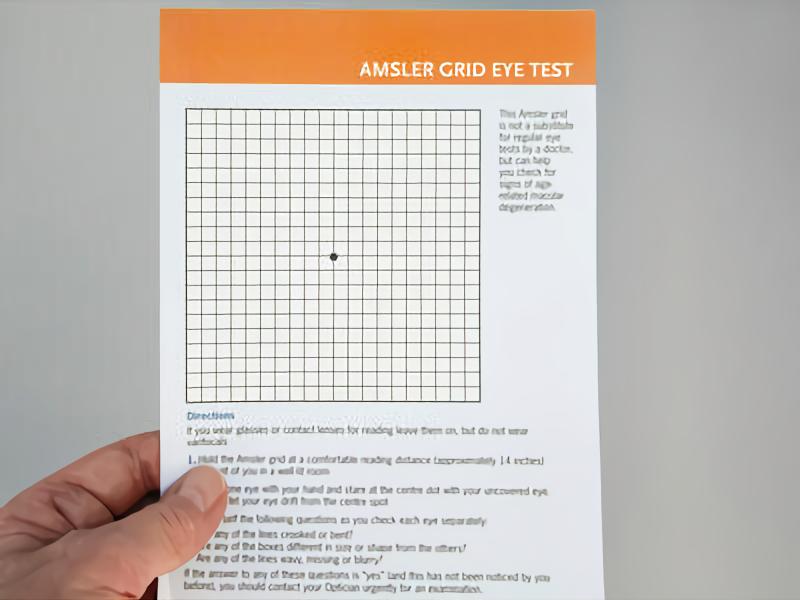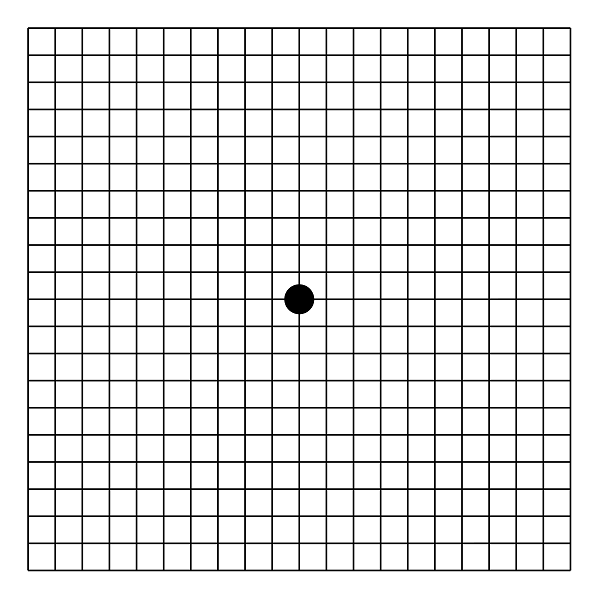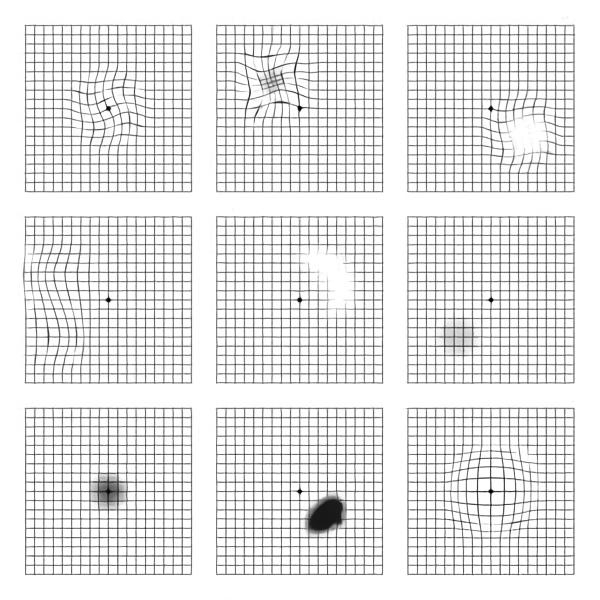What is the macular degeneration grid called?
The Amsler Grid is the grid test people refer to when monitoring their macular degeneration at home.
What is the Amsler Grid?
The Amsler grid is easy to use to monitoring test for macular degeneration. Download your free Amsler grid here and use the Amsler grid for home monitoring.
The Amsler grid is a test used by optometrists and ophthalmologists to diagnose visual impairments caused by macula damage (the central part of the retina).
It’s a basic square with a grid pattern and a dot in the center. When applied appropriately, this design may reveal trouble areas in your center area of view.
The Amsler grid is a horizontal and vertical line grid that is used to track a person’s central visual field. Marc Amsler, a Swiss ophthalmologist, created the grid. It’s a diagnostic technique that helps ophthalmologists spot vision problems caused by changes in the retina, especially the macula, such as AMD.
After a diagnosis of a retinal condition, the Amsler grid may be used to identify early indicators of the disease and track changes in vision.
If you have dry macular degeneration (AMD), an Amsler grid may help you keep track of your vision. The grid will aid you in detecting the disease’s progression from dry to wet AMD at an early, manageable stage.
How to use the macular degeneration grid (Amsler Grid)
Using an Amsler grid to test your eyes is simple and takes just a few minutes. Here’s how you do it:
- Do the test with good lighting you would normally read under.
- Wear your regular reading glasses (even if you just have store-bought reading glasses).
- Hold the Amsler grid 14 to 16 inches away from your face.
- Each eye should be tested separately: While testing one eye, cup your hand over the other.
- Answer the following questions while keeping your gaze fixed on the dot in the grid’s center:
- Is there anything wavy, blurry, or distorted about any of the lines in the grid?
- Do all of the squares in the grid seem to be the same size and shape?
- Is the grid free of “holes” (missing sections) or dark spots?
- Can you perceive all of the grid’s corners and edges (while maintaining your gaze on the center dot)?
- Cover the other eye and repeat on the other side.
In the macular degeneration test, the patient observes the little black dot in the middle of the grid with each eye independently. Wavy lines or missing lines may be seen in patients with macular disease.
Hold the grid at a distance that allows you to get most of the lines in focus while wearing reading glasses. If you use it with both eyes open, the good eye will compensate for the wet AMD eye, and you won’t notice any abnormalities.
All lines will seem straight to an eye without wet AMD. Wet AMD, on the other hand, causes parts of the lines to seem bent or even blacked out by a gray, white, or black zone. This is caused by fluid accumulating inside or behind the retina, which may form a blister, giving the appearance of curved straight lines. The fluid may sometimes create a gray, white, or black “blind spot” in or around the center of your visual field by interfering with retinal function.
When using the Amsler Grid to test your vision, if any holes or blurry patches emerge, or if the lines seem wavy, fuzzy, crooked, warped, or broken, you should contact your eye care practitioner right away; these are all possible indicators of AMD (Age-related Macular Degeneration). The Amsler Grid is not a replacement for routine eye examinations and testing, which should be done at least every two years, every year if you have the disease already.
If an eye with wet AMD is left untreated for longer than a few months, retinal scarring may occur. Because scarring may cause irreparable vision loss in sections of the visual field, it’s ideal to check your vision with the grid at least once a week at home and notify your retina doctor if anything changes. What exactly is a change? If your optometrist informs you that you don’t have wet AMD, glance at the grid right thereafter. That’s your starting point. Due to massive “drusen,” semi-solid deposits that accumulate behind the retina in AMD, the lines may be somewhat wavy in a few areas. If you then check again and believe the waviness has worsened, a new region has emerged, or you have a new “blind spot,” it’s time to see a retina doctor.
FAQ’s
Is an Amsler grid necessary for early-stage macular degeneration?
YES! This is when it is the most important, early detection is the key to preserving your vision. If you are consistent with using the test you will know early on when your vision is changing and can make an appointment with your eye doctor or low vision specialist to treat it as soon as it is warranted.
Is the Amsler grid for wet macular degeneration?
Yes, although once the disease has converted to the wet form and you’re being treated for it, the test isn’t as beneficial. It will show you progression or hopefully regression during treatment.
What causes dry Macular degeneration to change to the wet form?
Dry macular degeneration causes areas of the retina to become ischemic. This stimulates neovascularization which is new blood vessel formation. These new leaky blood vessels leak fluid into areas of the retina that can cause irreversible vision loss. These areas if left untreated can develop retinal scarring and further vision loss.
What does it mean when you see wavy lines?
Obviously, the lines on the grid are supposed to be straight horizontal or vertical lines. If the lines are wavy it could mean you have drusen as in the case of dry AMD or it could be the early signs of the wet form of the disease. In either case, its because there is something in or under the retina distorting it. If it is a change from your baseline. It should be checked.
What does the grid look like with intermediate macular degeneration?
The “intermediate” stage of macular degeneration would probably be considered the end stage of dry AMD. In this stage, you may notice some waviness to the lines on the grid but probably not any gray or missing areas.
Why do lines on the macular degeneration grid appear double?
If the lines look double you may have some large drusen distorting the retina. If this is a change from what the lines looked like on the Amsler grid test before, see your eye doctor.
How long do you look at the Amsler grid?
You only have to do the test long enough to determine if there is a change from your baseline. If just starting to monitor your vision you will do it long enough to determine if any of the lines are wavy or missing, if there are any grey or black spots and if you can see all four corners. Do each eye separately and at the same distance consistently.
How do they diagnose macular degeneration?
Macular degeneration is usually diagnosed when your eye doctor performs a dilated eye exam and looks at the macula with a special magnifying lens. The first signs of it are yellow spots called drusen. The wet form is diagnosed when fluid is seen under the retina either by this same type of exam or by a test called an OCT.
Is the macular degeneration grid test used to test for other forms of vision loss?
The Amsler test can also be used for screening for progression of Cystoid macular edema caused by diabetic retinopathy. It can be helpful in screening for disorders that have desaturated red side effects like pituitary tumors, toxic maculopathy from medications, and toxic optic neuropathy. The grid can be used in a black and red form. Grid #4 is to tell the difference between blind spots and distortions.
Should I document the results for my doctor?
Having a copy of the grid is a great idea, if you notice changes in your vision and defects on the test, you can dry on the copy what you see or don’t see. This will aid your doctor in knowing what may be occurring.
If I notice defects on the test should I go to my doctor immediately or wait to see if it resolves?
If changes are occurring the underlying condition is likely to resolve on its own. Although it isn’t an emergency to go straight to the doctor. It’s a good idea to get in as soon as possible.
Will new glasses help to fix the problems detected with the Amsler grid test?
No, getting new glasses won’t help with whatever condition is causing the defects on the test. It is probably a good idea to wait until your doctor tells you your condition is stable before spending the money on new glasses.
I have AMD in the family, should I do this test to monitor it for myself?
Early detection is always the goal, however, your eye doctor will probably detect the disease before you will doing the test. If you have AMD in the family be sure to have your eyes examined at least every two years up to the age of 50 and every year after that. You should also eat lots of green leafy vegetables, take an ARED2 vitamin and quit smoking if it runs in the family.

















